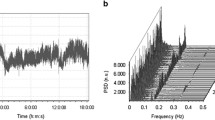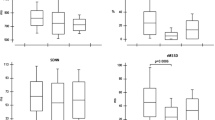Abstract
Purpose
Individuals with spinal cord injury (SCI) have an increased risk of cardiac arrhythmias, particularly during autonomic dysreflexia (acute hypertensive episodes). This may be partly due to impaired autonomic control of the heart after SCI. The interval between the peak and end of the T-wave of the electrocardiograph (ECG) provides an index of transmural dispersion of repolarisation, a factor underlying the development of ventricular arrhythmias. Another ECG-based risk factor for ventricular arrhythmias is variability in the QT segment, the QT variability index (QTVI). Similarly, P-wave variability may be correlated with risk for atrial arrhythmias. We aimed to: (1) determine whether there are abnormalities in these parameters at rest in those with SCI; (2) determine correlations between these ECG parameters and severity of autonomic impairment after SCI.
Methods
ECG intervals were determined using customised software from a 15 min ECG recording (lead II) in 28 SCI subjects and 27 controls. Autonomic severity of SCI was determined from sympathetic skin responses, low frequency systolic blood pressure variability, and plasma noradrenaline levels.
Results
Tpeak–Tend variability and QTVI were increased in those with autonomically complete SCI compared to controls. P-wave variability was increased in SCI individuals compared to controls, and was negatively correlated with plasma noradrenaline.
Conclusion
The higher Tpeak–Tend variability, QTVI and P-wave variability in individuals with SCI could be markers of severity of injury to cardiac autonomic (sympathetic) pathways after SCI, and may represent new risk assessment parameters for predisposition to cardiac arrhythmias in this population.




Similar content being viewed by others
References
Myers J, Lee M, Kiratli J (2007) Cardiovascular disease in spinal cord injury: an overview of prevalence, risk, evaluation, and management. Am J Phys Med Rehabil 86(2):142–152
Garshick E, Kelley A, Cohen SA, Garrison A, Tun CG, Gagnon D, Brown R (2005) A prospective assessment of mortality in chronic spinal cord injury. Spinal Cord 43(7):408–416
Rodenbaugh DW, Collins HL, DiCarlo SE (2003) Increased susceptibility to ventricular arrhythmias in hypertensive paraplegic rats. Clin Exp Hypertens 25(6):349–358
Krassioukov A, Claydon VE (2006) The clinical problems in cardiovascular control following spinal cord injury: an overview. Prog Brain Res 152:223–229
Claydon VE, Elliott SL, Sheel AW, Krassioukov A (2006) Cardiovascular responses to vibrostimulation for sperm retrieval in men with spinal cord injury. J spinal cord Med 29(3):207–216
Forrest GP (1991) Atrial fibrillation associated with autonomic dysreflexia in patients with tetraplegia. Arch Phys Med Rehabil 72(8):592–594
Verrier RL, Antzelevitch C (2004) Autonomic aspects of arrhythmogenesis: the enduring and the new. Curr Opin Cardiol 19(1):2–11
Guttmann L, Whitteridge D (1947) Effects of bladder distension on autonomic mechanisms after spinal cord injuries. Brain 70(Pt 4):361–404
Colachis SC 3rd, Clinchot DM (1997) Autonomic hyperreflexia associated with recurrent cardiac arrest: case report. Spinal Cord 35(4):256–257
Frankel HL, Mathias CJ, Spalding JM (1975) Mechanisms of reflex cardiac arrest in tetraplegic patients. Lancet 2(7946):1183–1185 (Pii S0140-6736(75)92662-8)
Collins HL, DiCarlo SE (2002) TENS attenuates response to colon distension in paraplegic and quadriplegic rats. Am J Physiol Heart Circ Physiol 283(4):H1734–H1739
Weaver LC, Marsh DR, Gris D, Brown A, Dekaban GA (2006) Autonomic dysreflexia after spinal cord injury: central mechanisms and strategies for prevention. Prog Brain Res 152:245–263
Antzelevitch C, Shimizu W, Yan GX, Sicouri S, Weissenburger J, Nesterenko VV, Burashnikov A, Di Diego J, Saffitz J, Thomas GP (1999) The M cell: its contribution to the ECG and to normal and abnormal electrical function of the heart. J Cardiovasc Electrophysiol 10(8):1124–1152
Antzelevitch C (2001) Tpeak-Tend interval as an index of transmural dispersion of repolarization. Eur J Clin Invest 31(7):555–557
Panikkath R, Reinier K, Uy-Evanado A, Teodorescu C, Hattenhauer J, Mariani R, Gunson K, Jui J, Chugh SS (2011) Prolonged Tpeak to Tend interval on the resting electrocardiogram is associated with increased risk of sudden cardiac death. Circ Arrhythm Electrophysiol 4:441–447
Piccirillo G, Cacciafesta M, Lionetti M, Nocco M, Di Giuseppe V, Moise A, Naso C, Marigliano V (2001) Influence of age, the autonomic nervous system and anxiety on QT-interval variability. Clin Sci (Lond) 101(4):429–438
Dilaveris PE, Gialafos JE (2001) P-wave dispersion: a novel predictor of paroxysmal atrial fibrillation. Ann Noninvasive Electrocardiol 6(2):159–165
Dilaveris PE, Gialafos JE (2001) P-wave duration and dispersion analysis: methodological considerations. Circulation 103(21):e111
Chung FP, Hu YF, Chao TF, Higa S, Cheng H, Lin YJ, Chang SL, Lo LW, Tuan TC, Tai CT, Li CH, Lin YK, Chen SA (2011) The correlation between ventricular repolarization and clinical severity of spinal cord injuries. Heart Rhythm 8(6):879–884
Marino RJ, Barros T, Biering-Sorensen F, Burns SP, Donovan WH, Graves DE, Haak M, Hudson LM, Priebe MM (2002) ANSC (2005) International standards for neurological classification of spinal cord injury. J Spinal Cord Med 26(Suppl 1):S50–S56
Alexander MS, Biering-Sorensen F, Bodner D, Brackett NL, Cardenas D, Charlifue S, Creasey G, Dietz V, Ditunno J, Donovan W, Elliott SL, Estores I, Graves DE, Green B, Gousse A, Jackson AB, Kennelly M, Karlsson A-K, Krassioukov A, Krogh K, Linsenmeyer T, Marino R, Mathias CJ, Perkash I, Sheel AW, Shilero G, Schurch B, Sonksen J, Stiens S, Wecht J, Wuermser LA, Wyndaele J–J (2009) International standards to document remaining autonomic function after spinal cord injury. Spinal Cord 47(1):36–43
Cariga P, Catley M, Mathias CJ, Savic G, Frankel HL, Ellaway PH (2002) Organisation of the sympathetic skin response in spinal cord injury. J Neurol Neurosurg Psychiatr 72(3):356–360
Claydon VE, Krassioukov AV (2006) Orthostatic hypotension and autonomic pathways after spinal cord injury. J Neurotrauma 23(12):1713–1725
Claydon VE, Steeves JD, Krassioukov A (2006) Orthostatic hypotension following spinal cord injury: understanding clinical pathophysiology. Spinal Cord 44(6):341–351
Bazett H (1920) An analysis of the time-relations of electrocardiograms. Heart 7:353–370
La Fountaine MF, Wecht JM, Rosado-Rivera D, Cirnigliaro CM, Spungen AM, Bauman WA (2011) The QT variability index and cardiac autonomic modulation: perspectives from apparently healthy men with spinal cord injury. Cardiology 117(4):253–259
Acknowledgments
We are grateful to Mr Inderjeet Sahota and Mr Brett Shaw for their assistance with this project. This work was supported by funding from the Heart and Stroke Foundation of Canada, the Christopher and Dana Reeve Foundation, and Simon Fraser University.
Author information
Authors and Affiliations
Corresponding author
Rights and permissions
About this article
Cite this article
Ravensbergen, H.J.C., Walsh, M.L., Krassioukov, A.V. et al. Electrocardiogram-based predictors for arrhythmia after spinal cord injury. Clin Auton Res 22, 265–273 (2012). https://doi.org/10.1007/s10286-012-0166-6
Received:
Accepted:
Published:
Issue Date:
DOI: https://doi.org/10.1007/s10286-012-0166-6




